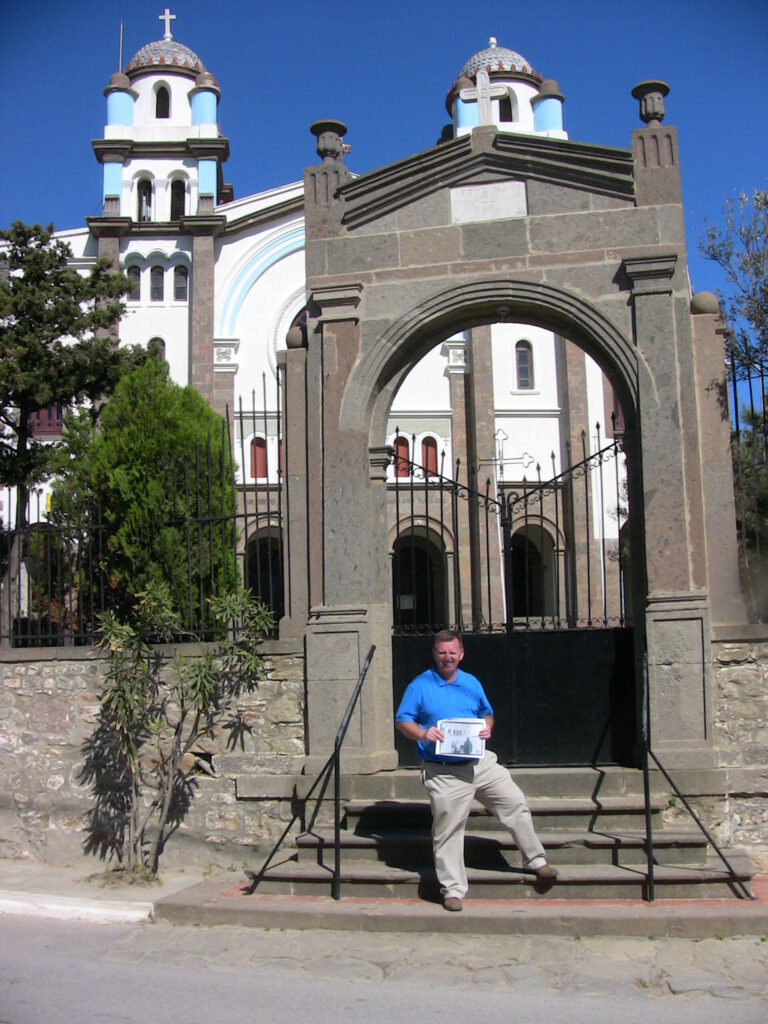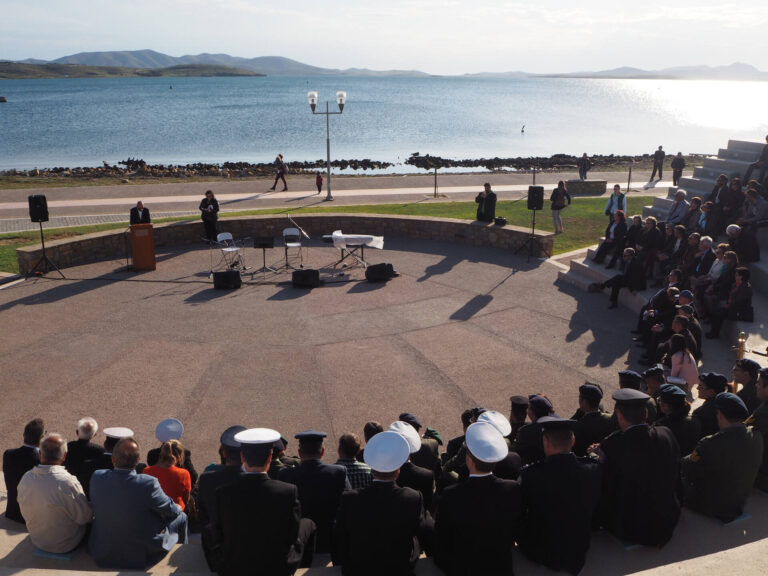Recently on a visit to friends in Bendigo the conversation turned to the Hellenic link to Anzac. Soon I was leafing through two old books, published during the First World War to commemorate the Australians who served, especially during the Gallipoli campaign. These books would provide more evidence of the role of Lemnos and Imbros in that campaign.
In showing us these treasured family heirlooms, our friends Damian Sherry and Judy Kneale explained that they were probably originally those of the family Gallipoli veteran, Private Ernest Kneale. While Ernest doesn’t appear to have left any personal accounts of his war, one of the books – the All-Australia Memorial published in 1917 – had his image and a short biography pasted into the front.

This book also contained images of Lemnos’ Mudros Bay, full of Allied ships, with tents on the shoreline. There was also a map which clearly identified both Imbros and Tenedos –two of the northern Aegean islands used by the Allies during the campaign – with a number of the villages and features of Imbros identified, including Cape Kefalo, Kastro and Agridia. The other publication – the Anzac Memorial book also from 1917 – contained a vivid account of another young soldier’s connection to both Lemnos and Imbros, the private diary of Thomas Murphy, a Sergeant in the Australian 1st Battalion.
Sergeant Thomas Murphy’s wartime chronicle
Sydney-born Thomas was 30 when he bid farewell to his wife Mary and two children, joining up in August 1914 on the outbreak of the war. A carter by trade with previous military experience, he was allocated to the Battalion’s headquarters. By October Thomas had been promoted to the rank of Sergeant Cook with responsibility for the Battalion’s rations and field kitchens as well as its complement of butchers, bakers and cooks. The Battalion departed Sydney in October 1914. We are fortunate that Thomas decided to keep his diary recording his wartime experiences, especially those concerning his connection to Lemnos and Imbros.

These references begin with his sailing into Lemnos’ Mudros Bay early on 12th April gazing at the Island from his transport, the Minneswaska. Thomas and the battalion had departed Alexandria on the Egyptian coast two days earlier, sailing across the eastern Mediterranean, noting the numerous steamers they passed along the way.
He writes of the troopship finding anchorage alongside British, French and Russian naval cruisers, reflective of the huge naval armada that was assembling at Mudros Bay prior to the landings at Gallipoli. Thomas writes of seeing torpedo boats signalling to the Minneswaska, ammunition being brought up on deck and naval officers boarding the ship. Thomas records that on the day of their arrival the Anzac Corps commander General Birdwood delivered a lecture to the officers and non-commissioned officers in the ship’s saloon. He recounts the movement of various naval vessels across the waters of the Bay, including submarines, destroyers, troopships and cutters. The Bay would soon be home to an estimated 200 naval vessels. Thomas records that the Australian transport Hymettus ran aground in Mudros Bay on April 22.

It would not be until April 16 that Thomas records his first time ashore at Lemnos. He describes walking through Mudros town and his encounters there. He writes of being photographed, by a soldier of the Royal Scots regiment, with a French officer and Greek soldier in Mudros. A few days later, he referred to the Ceylon Planters Rifle Corps joining the 1st Battalion aboard the Minnewaska. The Australians at Lemnos were soon appreciating the multinational nature of the Allied campaign at Gallipoli.
On the same day, Thomas visited the “Greek Orthodox Church” at Mudros, no doubt the great cathedral of Evangelismos Theotokou, which sits on a hill and dominates the town. As my research has shown this church was visited by many Australian soldiers and nurses during their time at Lemnos.
It is now that he writes of his visit to a local Greek school at Mudros. He records that the “teacher gets the school children to sing” for the visiting Australians. He doesn’t record the title or subject of the song but the performance obviously made an impression on Thomas, the Australian visitors leaving money for them. There are a number of photographs taken by Australian soldiers of school children such as that taken by an unknown soldier at the nearby village of Roussopouli.

Other Australians recorded similar visits to local schools. Private Henry Gissing wrote of visiting a local school in May with other soldiers of his unit, where the schoolchildren sang to the visitors, the Australians “giving a return with a concertina.” The history of the 12th Battalion records Lemnian children joining in on their march on the shore, the children in front carrying a Greek flag.
The day’s Mudros tour ends with Thomas’ group having lunch, visiting the French camp that was based around Mudros and then inspecting some of the windmills that surrounded the town. There are many photographs of Mudros at the time, showing the French presence there, with their French pier and their huge wine store. Records from the time reveal that many Australian soldiers met up with their French comrades at Mudros during their route marches or during their brief periods of leave, like that enjoyed by Thomas and his friends. Many also walked up to inspect the windmills as Thomas did, the young Australian nurse Evelyn Hutt having such a scene in her photographic collection.

Two days later Thomas returned to Mudros for another visit, witnessing the “christening of a child, and leave[sic] a present.” This probably took place in the Mudros Church that he had visited earlier. This reference reflects the intimacy of the coming together of these young Australians and their Lemnian hosts. Later he walks through the town enjoying “some Greek wine and bread” before returning to his ship in the bay. This reminds me of the many other references to Australians enjoying the food and beverages on Lemnos during their time there, recounted in my book Lemnos & Gallipoli Revealed.
During these days Thomas also records his visit with fellow 1st Battalion soldier Lieutenant Alfred Shout to the Royal Navy warship Queen Elizabeth, also anchored in the Bay, inspecting its 15-inch guns. He also writes of receiving a letter from his wife Mary and news that his mother has died, taking the opportunity to write home.

The Hellenic-Australian bond through Anzac eyes
Thomas departed the Bay as part of the convoy that sailed early on April 24 to anchor at Pournia Bay on Lemnos’ northern coast until 11pm at which time they sailed for Imbros and the final voyage to the landing on Anzac Cove on the morning of April 25. Thomas and his battalion then took part in the defence of the landing area. After a month’s fighting, Thomas writes of their being removed from Gallipoli for a short period of rest. It is here that he refers to his short but no doubt welcome stay on Imbros, the large island lying off the coast of Gallipoli. This was the closest safe harbour and resting place for Allied troops on the Peninsula. This major Allied base was home to large rest camps, centred around Kefalos Bay on its eastern coast. Thomas was one of hundreds of Allied soldiers sent to Imbros’ rest camps for short periods of respite from the horrors of the battlefields on the Peninsula. Thomas writes of seeing Ottoman prisoners at work around the Allied camp on Imbros, of resting and regular bathing parades during his eight-day rest period on Imbros.

His experience accords with my research, published in my book From Imbros Over The Sea. Thomas’ time on Imbros was part of the withdrawal of the Australian 1st Division troops from Gallipoli in June and July. Adelaide’s Captain Harry Nott described his time there as being “a perfect holiday picnic.” Soldiers like Thomas’ 1st Battalion comrade Lieutenant Alfred Shout hired donkeys from local villagers so they could traverse Imbros. His reference to Ottoman prisoners there is also documented in a number of Allied photographs.
Thomas and his battalion returned to the front on the Peninsula, taking take part in the bloody battle of Lone Pine in August. Initially diagnosed as suffering from conjunctivitis, Thomas was later found to have suffered a gunshot wound to his eye-lid. Treated initially at Anzac on 16 August, he was evacuated to Mudros Bay at Lemnos and then transhipped the next day to England for treatment. His injuries were such that he was repatriated back to Australia in late 1916, where he would be discharged with a war pension for himself and his family.
These individual human stories linking the Hellenic world to Australia and its Anzac story are found across Australia, in family and public archives. Their re-telling brings to life these distant stories relating to the interaction of ordinary Hellenes and these young Australians from the other side of the world. Sergeant Murphy’s touching account of the day the school children of Mudros sang for him and his comrades is testimony to the intimacy of that contact.
Jim Claven OAM is a historian, writer and author who has researched the Hellenic link to Australia’s Anzac story for many years. His publications include ‘Lemnos & Gallipoli Revealed’, ‘Grecian Adventure and From Imbros Over the Sea’. Jim can be contacted via email at jimclaven@yahoo.com.au.









